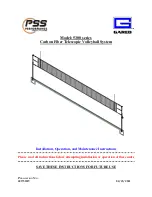
LINGO (CONTINUED)
Permanent Object:
Any object near the court or hanging over the court that interferes with the flight of the
ball. Permanent objects include the ceiling, walls, fencing, lighting fixtures, net posts, the stands and seats for
spectators, the referee, line judges, spectators (when in their recognized positions) and all other objects
around and above the court.
Rally:
Continuous play that occurs after the serve and before a fault.
Replays:
Any rallies that are replayed for any reason without the awarding of a point or a side out.
Service Court:
The area on either side of the center line, bounded by the non-volley line, the baseline, and
the sideline. All lines are included in the service court except the non-volley line.
Side Out:
Declared after one side loses its service and other side is awarded service.
Technical Foul:
The referee is empowered to add one point to a player’s score or a team’s score when the
opponent violates one of the rules calling for a technical foul or, in the referee’s judgment, the opponent is
being overly and deliberately abusive.
Volley:
Hitting the ball in the air, during a rally, before the ball has a chance to bounce onto the court.
STRATEGY
·
Try to keep serves firm and deep. Vary direction but make sure they’re in bounds.
·
Serve from near the center line so you can get at most returns more easily.
·
Try to keep returns deep and to the corners.
·
Generally stay near the back third of the court.
·
Try to force opponents to use their backhand, most players are weaker there.
·
Anytime you can, hit a deep forcing shot into the corners, where your opponent doesn’t have time
to set up for their shot. That gives you a chance to come to the non-volley line and hit a passing
shot.
·
Face your opponent. You’re in a better position to return a shot to either side.
·
Never hit a drop shot when your opponent is deep. Good players will get to it quickly and be in
position to hit a passing shot.
·
Vary your shots so opponents can’t anticipate you, occasionally try to make them think you’re
doing one thing but do another.
·
Generally move left or right as your opponent moves but stay closer to the center line.
·
Use lobs only when necessary and your opponent is at the net or non-volley line.
·
If your opponent has managed to get to the net and you are still back, then you have 3 choices - hit
a hard passing shot, hit a dipping shot that hits the ground at your opponent’s feet or hit a lob.
·
The best choice depends upon your skill level with each type of shot. The best players rarely lob
because it’s a difficult shot to hit deep enough to keep a good player from putting it away.
Content provided by our friends at the USA Pickleball Association (USAPA).
Learn more about the USAPA.
LINGO
Carry:
Hitting the ball in such a way that it does not bounce away from the paddle but tends to be carried
along on the face of the paddle during its forward motion.
Cross-court:
The court diagonally opposite your court.
Dead Ball:
A dead ball is declared after a fault.
Dink Shot:
A soft shot that is intended to arc over the net and land within the non-volley zone.
Double Bounce:
A ball that bounces more than once, on one side, before it is returned.
Double Hit:
One side hitting the ball twice before it is returned over net. Double hits may occur by one
player or could involve both players on a team.
Drop Shot:
A ground stroke shot that falls short of the opponent’s position.
Drop Shot Volley:
A volley shot that is designed to “kill” the speed of the ball and return it short, near the
net, to an opponent positioned at or near the baseline. This shot is especially effective when initiated close to
the non-volley line.
Fault:
A fault is any action that stops play because of a rule violation.
Ground stroke:
Hitting the ball after one bounce.
Half Volley:
A ground stroke shot where the paddle contacts the ball immediately after it bounces from the
court and before the ball rises to its potential height.
Hinder:
Any element or occurrence that affects play.
Let:
A serve that hits the net cord and lands in the service court. Let may also refer to a rally that must be
replayed for any reason.
Lob:
A shot that returns the ball as high and deep as possible, forcing the opposing side back to the baseline.
Non-Volley Zone:
The section of court adjacent to the net in which you cannot volley the ball. It includes all
lines surrounding the zone.
Second Serve:
A term used to describe the condition when a serving team begins the game or subsequently
loses the first of its two allocated serves.
Overhead Slam / Smash:
A hard, overhand shot usually resulting from an opponent’s lob, high return, or
high bounce.
Passing Shot:
A volley or ground stroke shot that is aimed at a distance from the player and is designed to
prevent return of the ball.
(www.USAPA.org).
- -
7








































